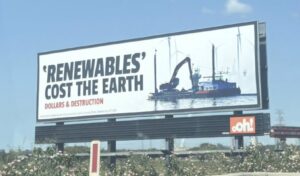Living in an isolated country with a small population, Australians should be used to the occasional huge shock from the outside world. Whether helpful or terrible, these shocks will always be transformative.
As an example of a traumatic shock, think what our indigenous peoples received in 1788. As an example of a helpful shock, think of the growth of East Asian economies in recent decades. All would agree that the Chinese demand for our raw materials is transforming our economy; most would agree the changes are for the better. Or if we can’t agree on the merits of that transformation, think about developments in telecommunications and the internet, in which the outcomes of R&D and commercialisation done overseas have been rapidly adopted in Australia.
My contention is that another big shock is coming. It’s renewable energy, and solar power in particular.
With respect to renewable energy, many influential Australians wear blinkers, just like a horse that must not be frightened. Australia has about 9% of the world’s coal reserves and perhaps 1.5% of its natural gas. An extractive national mentality is reinforced by immense deposits of iron ore and major resources of other minerals – gold, bauxite and copper to name just a few. That really shapes the nature of our economy, our politics, our media, even our ethos.
Internationally, there are several drivers for development of renewable energy – these include access to energy, energy security, a desire to avoid costly imports, development of local industry and concerns about anthropogenic climate change.
In Australia, we have ready access to energy, energy security is not a problem, we have a trade surplus in energy, and our weak manufacturing sector doesn’t concentrate on elaborately transformed manufactures such as wind turbines and PV panels. As for climate change, if your stomach is strong enough you can visit Australian websites like www.nocarbontax.com.au to see widely-held denialist views.
Most of those international drivers for renewable energy don’t apply here, so you wouldn’t expect us to be leading the race to produce and install renewable energy devices. And we aren’t!
But those drivers do apply elsewhere.
I’ll discuss two examples, the first being Germany. There, winters are cold and expectations high; the population demands access to energy. Although Germany has substantial deposits of brown coal, the bulk of their fossil fuel energy comes from regimes that are less than fully reliable. Naturally German economists would prefer that foreign exchange was not spent on expensive fossil fuel imports. Germany has a wonderful manufacturing sector able to produce any sort of renewable energy device. And lastly, the Green movement is strong, resulting in a national consensus to eliminate nuclear energy and reduce CO2 emissions. Little wonder that cool-headed, far-thinking Germany is a world leader in renewable energy. By the way, please bear in mind that the ruling coalition is on the conservative side of politics.
My second example is China. Again the population wants access to energy for industrial development and human comfort. In 2008, China had 14% of the world’s coal reserves, but these are being used rapidly. The Chinese must cope with the challenge of securing energy in competitive world markets. They want to use their foreign exchange in a more strategic way than spending on energy imports. They are definitely building up manufacturing capabilities in high-technology goods and elaborate manufactures. And, lastly, the population is surely heartily sick of growing environmental degradation, such as the recent instance of smog from coal-fired power plants swamping Beijing.
Note that China has a command economy in which the leadership takes strategic decisions and implements them in five-year plans. In a decade or so, China will have the biggest economy in the world. They will produce goods that will shape activities in the rest of the world. Would you like to guess what they are investing in today? Amongst others, that would include factories to produce wind turbines and PV panels. That will be followed by investments in batteries and perhaps solar thermal power.
Let’s discuss a few facts about PV.
As manufacturers become more skilled and operate on a larger scale, the price of goods falls. With PV modules, the price per Watt in constant dollars is falling by 22% for each doubling of cumulative production. That trend has held for more than 30 years and is still intact.
Together with supportive government policies, this has led to an explosion in annual PV installations, which grew worldwide at an average rate of 44% per year over 10 years from the start of this century. Worldwide, 28 GW of grid-connected PV was installed in 2011. You don’t need to be a mathematician to work out what will happen if these growth rates hold for a few more years, as would seem to be both technically achievable and likely in view of strategic decisions taken in boardrooms in countries like Germany and China.
What are the implications for Australia?
Clearly, the price of PV panels will continue to fall. This will happen at the same time that the cost of electricity from the grid goes up. Already we have “socket parity”, in which PV electricity is comparable in price with grid electricity provided it can be used at the time of generation. If there are beneficial developments with batteries, then the situation for PV will become even more favourable. Consumers will simply abandon the grid.
Such developments will take place even quicker in China. You can expect the Chinese to make herculean efforts to reduce fossil fuel consumption and clean up their environment. The fervour will spread to other big Asian economies. A big export market for Australia is at risk. Assets that feature strongly on our stock market and superannuation plans run the risk of being stranded. In this scenario, a large sector of our economy would be destroyed, jobs lost and wealth evaporated.
Note also that an explosion of installations for wind-power started about 5-10 years earlier than for PV, and might well be followed about 5-10 years later than for PV by solar thermal power.
Let us also heed the warnings of climate scence. Anthropogenic climate change is happening, in some ways faster than predictions of the Intergovernmental Panel on Climate Change. A substantial fraction of the planet’s carbon reserves must be left unburnt if we are to keep temperature increases to a tolerable level. When the effects of climate change are visible enough, governments around the world will take decisive action to eliminate CO2 emissions. Moreover, insurance companies will simply refuse to write policies for protection against climate change. Those developments will strengthen conclusions drawn above about stranded assets.
If you are interested in reading further about these trends, I commend A Global Forecast for the Next 40 Years by Jorgen Randers. It’s an extremely thought-provoking book.
To conclude with an automotive analogy, the Australian economy is accelerating along a dead-end road, pedal to the metal. Opinion-shapers in Australia can’t see the big problem ahead, or perhaps they are unwilling to look. To persuade the electorate to stop and turn around will not be easy, but it is surely preferable to take action through enlightened self-interest than to have change forced on us by the outside world.
This is the text of a speech delivered to the SEARCH Foundation on 7 February 2013










